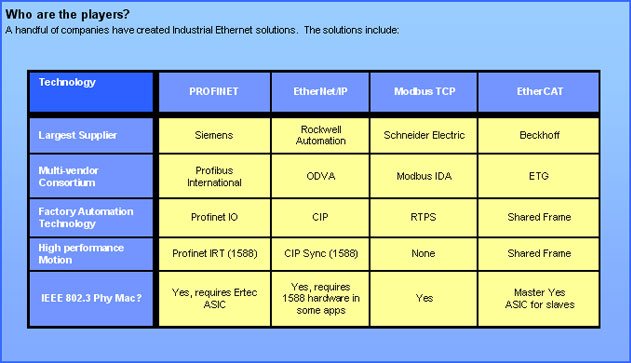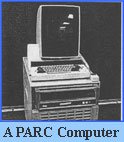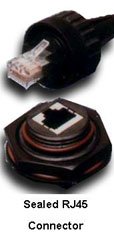What is Industrial Ethernet
How Does it Differ from Commercial Ethernet?
Introduction
Ethernet is a well known and recognized technology in the home and office environment. Recently it has become the hottest trend in moving data in industrial applications on the factory floor. The factory floor however is a much different environment than home and office environments. Factory floor applications also present many different needs than commercial applications. This paper highlights the differences between industrial and commercial Ethernet by comparing:
- Communication Needs
- Process Concerns
- Environmental Challenges
- Hardware
Let’s Communicate
Industrial Ethernet has unique requirements based on two-way communications. To understand this, lets think about a possible application; a bottle-filling plant. Let’s assume Real Time Automation is creating a new microbrew beer, Automation Ale. The filling operation will be run on an Industrial Ethernet network.
The network works well because it uses “handshaking”to ensure message delivery. To illustrate this attribute let’s say our bottling device begins filling a bottle of Automation Ale at the command of the controlling PLC. The PLC is also responsible for sending the “stop filling” command when the bottle is full. If the message is lost on the network the PLC is aware because it does not received a delivery response from the filler, (part of the handshaking) so it knows to resend the command.
In the office setting, such a lost transmission is rarely important. If a webpage gets lost in transmission, the user simply presses “refresh.” In the production setting, though, we can’t wait for Automation Ale to spill on the floor before someone manually turns off the filler. The handshake saves ale, money and time.
In an Industrial Ethernet network, we also incorporate collision detection. If two messages collide in our network, the controlling PLC can resend the message to the device until it receives a delivery notice for the device. These transactions occure over just a few miliseconds. Ale continues its controlled pour and no one in the Brew City of Milwaukee is enraged by wasted beer.
Automation Ale is quite popular in our scenario, so let’s assume we need a few dozen bottlers, valves, sensors, and a PLC in our network. The magnificent operation must run at peak efficiency, an office Ethernet network would not accomplish this goal. That is because there is no collision detection.
What are other factors to consider?
Operations Concerns
Another area of concern regards the specific needs of your plant operations. Take, for instance, the cost of downtime. When a network goes down in your Office setting, it is an inconvenience. Some work may be impossible. Often, an employee will simply need to move on to another task and tackle it without useing the internet.
In a production setting, that downtime can be more costly. Assembly lines operating with continual processes can be rendered nonfunctional if one aspect fails. Critical processes could be ruined, leading to lost material, and money.
Think for a minute of a factory producing tempered glass for windows. A continues flow of glass moves from pour, to cut, over an assembly line a mile long. Going through specific heat-ups, cool-downs, and rests to properly temper it to defined specifications. If the line seized you would be left with a mile of scrap glass. Much of it that would have to removed manually due to the fact it had cooled hard on a portion of the line that was meant to deal with hot malleable glass.
When designing an Industrial Ethernet network, you must consider options that make your network reliable. That often leads to increased costs.
Security Ethernet SecuritySecurity is another concern. In an Office setting, the information traveling through the network can be confidential and important. Thus, an Office Ethernet network must guard against unauthorized use. The same is true in an industrial application. Another security threat in the industrial setting is the risk that an employee may break the system accidentally, creating a Garbage In/Garbage Out scenario or, worse, bringing the device or network to a complete halt.
Ethernet SecuritySecurity is another concern. In an Office setting, the information traveling through the network can be confidential and important. Thus, an Office Ethernet network must guard against unauthorized use. The same is true in an industrial application. Another security threat in the industrial setting is the risk that an employee may break the system accidentally, creating a Garbage In/Garbage Out scenario or, worse, bringing the device or network to a complete halt.

Are the Office and Shop Floor Different?
It doesn’t take a genius to notice that there are differences between the corporate office setting and the industrial setting. You wouldn’t expect to see someone in the industrial setting wearing a Italian suit, or expensive leather shoes. It is much more suitable for them to be wearing blue jeans and steel-toed boots. These choices offer more protection from the environmental factors in the factory. The same attire considerations need to be taken for your Ethernet networks.
Industrial Ethernet cables, switches and connectors need to withstand the unique and harsh criteria in an industrial setting.
What are the Environmental Concerns?
Temperature
Heat and cold are two factors that can have a major effect on a network. Cold is particularly damaging. At relatively cold levels, near freezing, a cable is susceptible to impact, which can cause a break in the cable, destruction of the protective jacket, or attenuation. At even colder temperatures, the cable may become brittle and break through no large force, but instead through simple bending.
Heat is also damaging. The protective jacket may melt, leading to shorts and vulnerability. Heat also causes attenuation over time. Cables may not become physically susceptible when exposed to heat, but they can be made just as ineffective over time.
Chemicals
The Industrial Ethernet environment is harsh, and Office Ethernet applications were not created for such environments. Taking measures to physically protect cables and connectors can minimize, or even negate, the effects of an industrial environment.
Factory Noise
Electric and magnetic noise generated by large motors and high voltage devices can distort data transfers on the network. This interference can impede the throughput of your network or corrupt messages altogether.
Vibrations
Some processes may create vibration. Vibration can cause degradation of the jacket and disconnection if poor connectors are used. You must consider what will happen when the machines switch is turned on.
The History of Ethernet
 Ethernet was originally developed at Xerox PARC. In 1975, Xerox filed a patent application listing Robert Metcalfe, David Boggs, Chuck Thacker and Butler Lampson, as inventors.
Ethernet was originally developed at Xerox PARC. In 1975, Xerox filed a patent application listing Robert Metcalfe, David Boggs, Chuck Thacker and Butler Lampson, as inventors.
PARC Computer Metcalfe left Xerox in 1979 to promote the use of personal computers and local area networks (LANs), forming 3Com. He convinced DEC, Intel, and Xerox to work together to promote Ethernet as a standard, the so-called “DIX” standard, for “Digital/Intel/Xerox”; it standardized the 10 megabits/second Ethernet, with 48-bit destination and source addresses and a global 16-bit type field. The standard was first published on September 30, 1980. It competed with two largely proprietary systems, token ring and ARCNET, but those soon found themselves buried under a tidal wave of Ethernet products. In the process, 3Com became a major company.
Outside of temperature, other major environmental concerns exist. Chemicals may cause a jacket to dissolve or change shape, leading to a shorter life and worse performance. Some solvents can also directly impact the internal cable, should the protective jacket not be effective. Other environmental factors are less damaging, but still problematic. Radiation, especially UV Radiation from sunlight, can cause discoloration and degradation of the jacket. Humidity can also degrade the cable.
What are some other notable differences between Industrial Ethernet and Office Ethernet?
Topology
Commercial Ethernet is almost always configured in a star topology. Industrial Ethernet has many different topology options to fit diverse industrial applications. The topologies include star, tree, line, and ring topologies
Heavy and Light Duty
Another notable difference relates to use. Office Ethernet components are designed for a base level of use. Industrial Ethernet components can be considered for multiple levels of use and environmental abuse. Thus, Industrial Ethernet components can be divided into heavy and light duty categories. To fully understand the need for two classifications, let’s look at two common components. It is of interest to note you could go to Best Buy and purchase consumer switches, hubs, and cables and they would work in a Industrial applications. The question is for how long. These consumer goods are not designed for industrial applications and would soon fail.
Cable
First, cables can be classified as heavy or light duty. A light duty Industrial Ethernet cable may have slightly higher quality jacketing than Office Ethernet cable. The cable may even be an Office Ethernet cable if the conditions do not require extra protection. As you rise to heavy duty cable, though, the jacket and metals improve, though. At some point, you begin to see complex and thick jackets around incredibly high-quality cable. Heavy duty cable is more expensive than light duty cable, so it is only used when necessary.
Connectors
 Sealed RJ45 Connector Similarly, connectors can fall on a spectrum from Office to light duty and up to heavy duty. Typically, Industrial Ethernet connectors will not rely on basic snap-in lock mechanisms on the same level as Office Ethernet. Instead, heavier lock mechanisms are used. In heavy duty applications, sealed connectors are often used. Connectors can be just as important as cabling.
Sealed RJ45 Connector Similarly, connectors can fall on a spectrum from Office to light duty and up to heavy duty. Typically, Industrial Ethernet connectors will not rely on basic snap-in lock mechanisms on the same level as Office Ethernet. Instead, heavier lock mechanisms are used. In heavy duty applications, sealed connectors are often used. Connectors can be just as important as cabling.
Industrial light and heavy duty parts carry a premium price tag when compared to commercial components.
Conclusion
Ethernet is quickly becoming a well know and used technology on the factory floor. It offers cost, data volume, and transmission speed improvements over it’s fieldbus predecessors in industrial applications. Industrial Ethernet is able to effectively deal with harsh environments, data collisions, factory noise, and factory process needs. It’s still Ethernet, just Ethernet designed to fulfill unique industrial needs.
